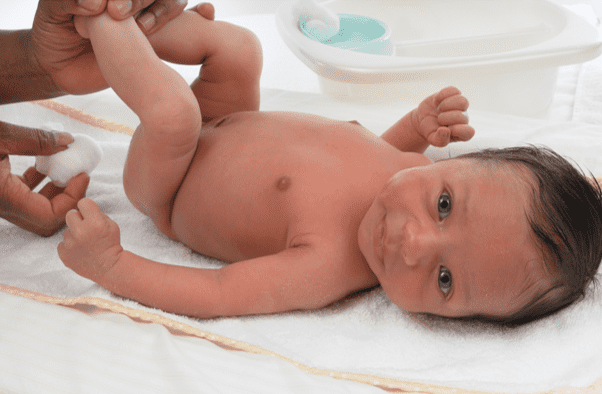Understanding Newborn Skin
Cheryl Samuels
Midwife, Project Lead All4Birth
Instagram @all4birth

Summary
The physiology of a newborn baby’s skin is delicate, and it is important to understand how the skin develops in the first few weeks of life and how to care for their sensitive skin. Therefore, careful consideration should be taken when deciding what cleansing agents and products to use on a baby’s skin.
Newborn Skin
In utero, a baby’s skin has been surrounded by the amniotic fluid in a controlled temperature environment. During this time, a natural substance called vernix caseosa covers the skin, which may still be visible after birth and is made from a powerful combination of proteins, fatty acids and antimicrobial peptides. It acts as a protective barrier that has antibacterial, antifungal, anti-infective and wound-healing properties and continues to protect the skin after birth. Lipid-rich vernix is a natural moisturiser and skin cleanser. Therefore, vernix mustn’t be removed at birth.1,2,3
The skin is the largest organ of the body and contributes to the body’s defence mechanisms. It acts as a barrier to bacteria, balances water and electrolytes, and stores fat to help regulate body temperature. A newborn’s skin is very sensitive and around five times more absorbent than an adult’s. It can take around four weeks for a baby’s skin to build up a protective barrier of natural enzymes, so it is very important to consider what is applied to a newborn’s skin during this time.2
Nappy Changing
Parents have a choice between disposable or reusable nappies, with some local councils in the UK offering contributions or incentives towards reusable nappy use. Nappies should be changed as often as needed to keep a baby’s skin clean and dry. The skin should be cleaned each time, after both wet and soiled nappies. When the cord is attached it is important to keep it out of the nappy, by folding down the top to fit just underneath the stump. This allows the cord to stay clean and dry, helping to minimise any risk of infection from contamination.1
Nappy Rash
To cleanse the skin, warm water and cotton wool is recommended for the first four weeks to minimise irritation and disrupting the natural protective layer of enzymes on a newborn’s skin. It is important to dry the area gently and thoroughly afterwards.1 Around 25-30% of all babies and toddlers wearing nappies will suffer from nappy rash,2 which can be caused by:
- a baby’s skin being in contact with wet or soiled nappies for a long time
- the nappy not fitting well and rubbing against a baby’s skin
- not cleaning or drying the nappy area effectively or changing the nappy often enough
- soap, detergent, or bubble bath
- alcohol-based baby wipes
- a fungal infection
- a baby recently taking antibiotics.
There may be red patches on the baby’s bottom, or the whole area may be red. Their skin may look sore and feel hot to touch, and there may be spots, pimples, or blisters. Most babies with mild nappy rash do not feel sore, but if the rash is severe your baby may feel uncomfortable and be distressed. If the area looks infected, it is important to seek medical attention for treatment.1,2,4 A nappy cream can be applied to the skin as a treatment for nappy rash or as a preventative measure. While this is not supported by evidence it is suggested as the best expert recommendation.1,2
Conclusion
Nappy changing and skincare can provide a wonderful opportunity for bonding between parent and baby. The close proximity of parent-baby allows direct eye contact where a newborn can start to process happy facial expressions and gentle voice tones. Using therapeutic touch can promote calmness and security, providing benefits to both baby and parent enhancing a sense of attachment, bonding and wellbeing.3
Links to resources
 Websites
Websites
Nappy rash | Health topics A to Z | CKS | NICE https://cks.nice.org.uk/topics/nappy-rash/
The Toxic Baby – YouTube https://youtu.be/qTT695taHb0
References
Oshikanlu R, Edwards J. Module 4. The prevention, treatment and management of nappy rash in newborns and infants. Journal of Health Visiting 2013;1(4):1-7.
Burdall O, Willgress L, Goad N. Neonatal skin care: Developments in care to maintain neonatal barrier function and prevention of diaper dermatitis. Pediatric dermatology 2019;36(1):31-35.
Cleveland L, Hill C M, Pulse W S, DiCioccio H C, Field T, White-Traut R. Systematic review of skin-to-skin care for full-term, healthy newborns. Journal of Obstetric, Gynecologic & Neonatal Nursing 2017;46(6):857-869.
Postnatal care [NG194] https://www.nice.org.uk/guidance/ng194 : Updated: 20 April 2021















